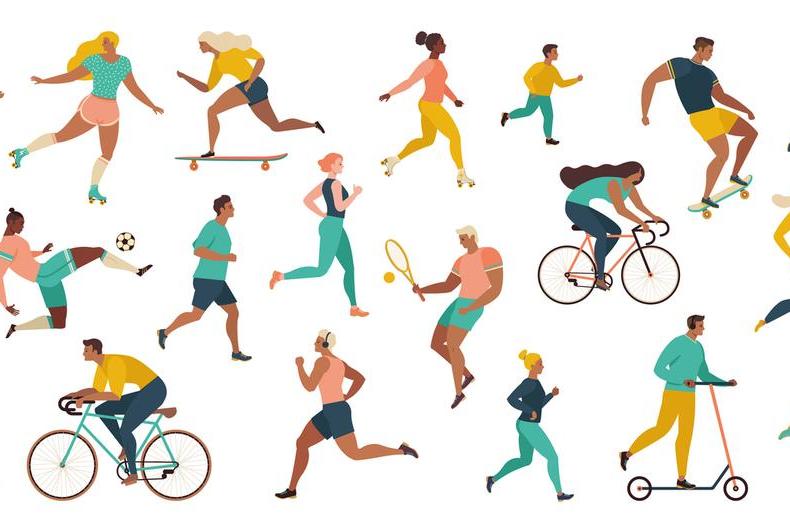Mental Health Awareness Week: Moving with awareness
LawCare sets out how movement and activity support your brain at a chemical level.

We all know that being active is important for our physical and mental health.
LawCare shares some reflections on looking beyond the obvious benefits of being active and take a deeper dive into the field of neuroscience, which demonstrates the interconnectedness of our mind and body when it comes to our mental health.
Developing awareness of the way we move and understanding our body’s signals can help us regulate our emotional and physical states, particularly during times of stress.
Neuroscience research shows how our nervous system plays a crucial role in how we experience and respond to stress, anxiety and other difficulties in our brains and bodies.
Each day we ebb and flow between the states of our nervous system that either activate or calm us.
Whilst fluctuations in our mood and energy are normal as we respond to daily challenges, spending too long at the extreme end of either state can negatively impact our physical and mental health.
There is a healthy range around the middle of this spectrum, called ‘the window of tolerance’.
Within this range, we can cope with the challenges of life without completely withdrawing or feeling overwhelmed.
When we find ourselves out of balance, one of the ways to return to, and broaden, our window of tolerance is through awareness and the intentional use of movement.
Awareness as a starting point
Find a comfortable sitting position and then close your eyes.
Scan your body to track what sensations you notice - this might be an unfamiliar or uncomfortable activity, but give it a go.
Can you feel the beating of your heart, tension in your muscles, the clenching of your stomach? Maybe you sense something else? Perhaps you are not detecting anything at all.
Welcome to “interoception” – your brain’s perception of your body’s state, transmitted from receptors in our internal organs.
Interoception can be strengthened by physical activity as it shifts our focus away from our thoughts and into the present moment.
Our sensitivity to interoceptive signals can make us more aware of how our thoughts and feelings are affected by physical cues, and help us connect our general state with what’s going on in our life.
Why it’s not that easy
Although the benefits of being active and moving with awareness are clear, that doesn’t mean it’s always easy to do.
There can be health limitations, competing priorities and various other challenges.
Externally - prioritising family and work commitments, and internally – traits of perfectionism, workaholism and negative beliefs such as feeling not good enough.
These patterns can keep our nervous system activated and perpetuate cycles of stress and pressure, which can mean we are unaware of our bodies and how we move them.
We can lose the motivation to focus on ourselves and it can feel frustrating to be reminded of the importance of movement.
It might seem insignificant in the context of the challenges and difficulties in our lives. Noticing how little we prioritise ourselves and taking stock of our belief systems (that might judge us as selfish or indulgent to be focusing on ourselves), is an important part of the process.
Tips for moving with awareness
Our relationship with our bodies and our overall health is a lifelong journey, but in order to see change and really get the benefits it’s important to have a few strategies to experiment with.
1. Get to know your existing relationship with movement and your body – what works and feels good? What keeps you stuck in your chair?
2. Create a new movement habit that works for you and which you enjoy - the simple act of practising any behaviour every day helps it to become a larger habit.
3. Start small – try small movements such as changing posture and observe any difference. If you find yourself hunched over your laptop during a busy day and are tempted to reach for your smart phone to distract you, instead you might try:
- gentle neck stretches from left to right and lowering your chin to your chest.
- lengthening your spine and gently twist the torso to each side, sitting upright.
- putting your hands on your hips and breathe in deeply and then sigh out. Repeat.
4. When your stress response is switched on: you might be holding your breath, feeling tension in your muscles, restlessness, fear - try any activity that gets you out of your head and into your body: strength training, vigorous exercise, or yoga.
Physical activity can reduce the level of stress hormones that are activated, and it boosts chemicals such as dopamine and serotonin which can improve mood as well as brain functions like memory and cognition.
5. If you notice that your energy has dropped: you might feel lethargic, disconnected, depressed, foggy brained or numb.
These are signs to activate the energy in your body. Try any physical activity that increases your heart rate and gets your body moving; stretching, changing posture or walking.
Can you take time to pay attention to what your body is communicating to you? Notice shifts in your internal state by listening to your body with intention, attention and using the action of movement. If you find you don’t have time for that - that might be the first thing to pay attention to.
Claire Jacques is a former lawyer who has retrained as a UKCP registered psychotherapist, group facilitator and trainer with Lawsight Ltd. Claire is also a supporter and Champion for LawCare.

